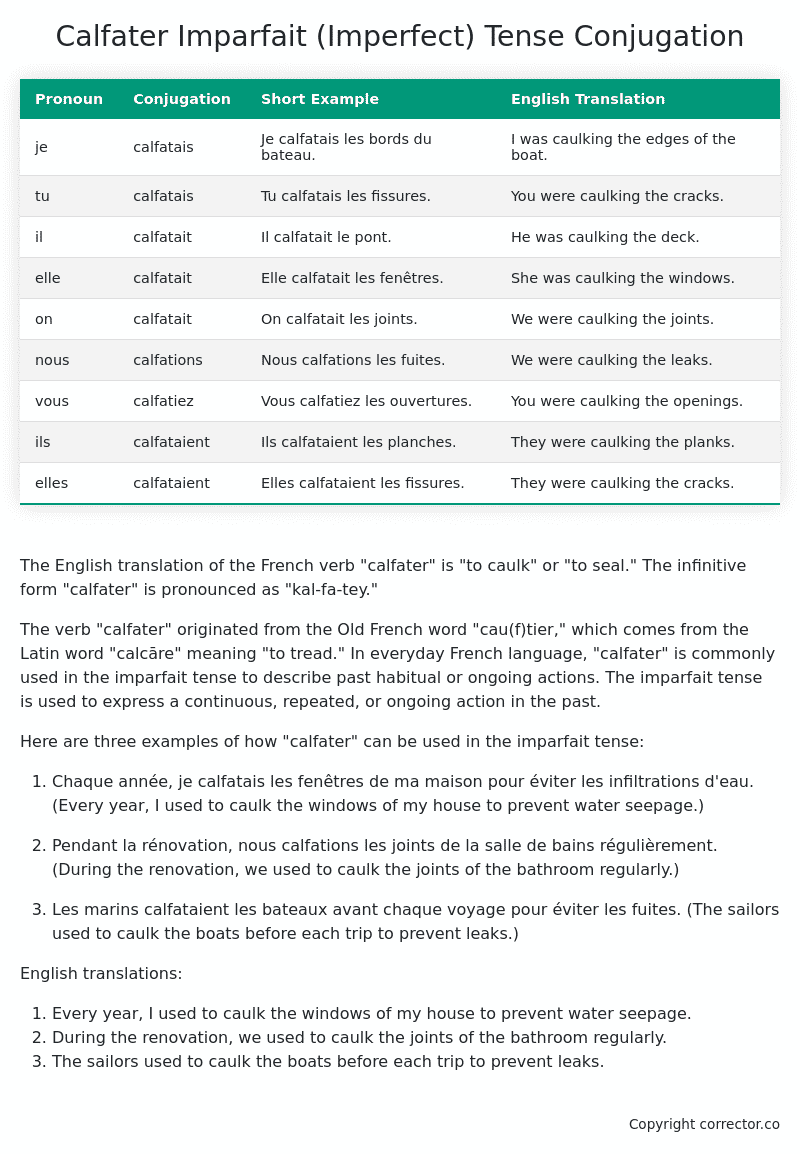Imparfait (Imperfect) Tense Conjugation of the French Verb calfater
Introduction to the verb calfater
The English translation of the French verb “calfater” is “to caulk” or “to seal.” The infinitive form “calfater” is pronounced as “kal-fa-tey.”
The verb “calfater” originated from the Old French word “cau(f)tier,” which comes from the Latin word “calcāre” meaning “to tread.” In everyday French language, “calfater” is commonly used in the imparfait tense to describe past habitual or ongoing actions. The imparfait tense is used to express a continuous, repeated, or ongoing action in the past.
Here are three examples of how “calfater” can be used in the imparfait tense:
-
Chaque année, je calfatais les fenêtres de ma maison pour éviter les infiltrations d’eau.
(Every year, I used to caulk the windows of my house to prevent water seepage.) -
Pendant la rénovation, nous calfations les joints de la salle de bains régulièrement.
(During the renovation, we used to caulk the joints of the bathroom regularly.) -
Les marins calfataient les bateaux avant chaque voyage pour éviter les fuites.
(The sailors used to caulk the boats before each trip to prevent leaks.)
English translations:
- Every year, I used to caulk the windows of my house to prevent water seepage.
- During the renovation, we used to caulk the joints of the bathroom regularly.
- The sailors used to caulk the boats before each trip to prevent leaks.
Table of the Imparfait (Imperfect) Tense Conjugation of calfater
| Pronoun | Conjugation | Short Example | English Translation |
|---|---|---|---|
| je | calfatais | Je calfatais les bords du bateau. | I was caulking the edges of the boat. |
| tu | calfatais | Tu calfatais les fissures. | You were caulking the cracks. |
| il | calfatait | Il calfatait le pont. | He was caulking the deck. |
| elle | calfatait | Elle calfatait les fenêtres. | She was caulking the windows. |
| on | calfatait | On calfatait les joints. | We were caulking the joints. |
| nous | calfations | Nous calfations les fuites. | We were caulking the leaks. |
| vous | calfatiez | Vous calfatiez les ouvertures. | You were caulking the openings. |
| ils | calfataient | Ils calfataient les planches. | They were caulking the planks. |
| elles | calfataient | Elles calfataient les fissures. | They were caulking the cracks. |
Other Conjugations for Calfater.
Le Present (Present Tense) Conjugation of the French Verb calfater
Imparfait (Imperfect) Tense Conjugation of the French Verb calfater (You’re reading it right now!)
Passé Simple (Simple Past) Tense Conjugation of the French Verb calfater
Passé Composé (Present Perfect) Tense Conjugation of the French Verb calfater
Futur Simple (Simple Future) Tense Conjugation of the French Verb calfater
Futur Proche (Near Future) Tense Conjugation of the French Verb calfater
Plus-que-parfait (Pluperfect) Tense Conjugation of the French Verb calfater
Passé Antérieur (Past Anterior) Tense Conjugation of the French Verb calfater
Futur Antérieur (Future Anterior) Tense Conjugation of the French Verb calfater
Subjonctif Présent (Subjunctive Present) Tense Conjugation of the French Verb calfater
Subjonctif Passé (Subjunctive Past) Tense Conjugation of the French Verb calfater
Subjonctif Imparfait (Subjunctive Imperfect) Tense Conjugation of the French Verb calfater
Subjonctif Plus-que-parfait (Subjunctive Pluperfect) Tense Conjugation of the French Verb calfater
Conditionnel Présent (Conditional Present) Tense Conjugation of the French Verb calfater
Conditionnel Passé (Conditional Past) Tense Conjugation of the French Verb calfater
Conditionnel Passé II (Conditional Past II) Tense Conjugation of the French Verb calfater
L’impératif Présent (Imperative Present) Tense Conjugation of the French Verb calfater
L’impératif Passé (Imperative Past) Tense Conjugation of the French Verb calfater
L’infinitif Présent (Infinitive Present) Tense Conjugation of the French Verb calfater
L’infinitif Passé (Infinitive Past) Tense Conjugation of the French Verb calfater
Le Participe Présent (Present Participle) Tense Conjugation of the French Verb calfater
Le Participe Passé (Past Participle) Tense Conjugation of the French Verb calfater
Struggling with French verbs or the language in general? Why not use our free French Grammar Checker – no registration required!
Get a FREE Download Study Sheet of this Conjugation 🔥
Simply right click the image below, click “save image” and get your free reference for the calfater imparfait tense conjugation!

Calfater – About the French Imparfait Tense
NOTE: To take a deep dive into all the French tenses then see our article on Mastering French Tense Conjugation.
Formation of the Imparfait Tense
For regular -er verbs:
For regular -ir verbs
For regular -re verbs
Common Everyday Usage Patterns
Description of Past Habits
Background Information
Mental and Emotional States
It’s employed to express emotions, thoughts, or physical sensations in the past. For example: “J’étais content quand il est arrivé.” (I was happy when he arrived.)
Ongoing Actions
Points to Note About the Imparfait Tense
Passé Composé vs. Imparfait
Conditional
Si Clauses
Narration
I hope you enjoyed this article on the verb calfater. Still in a learning mood? Check out another TOTALLY random French verb imparfait conjugation!


